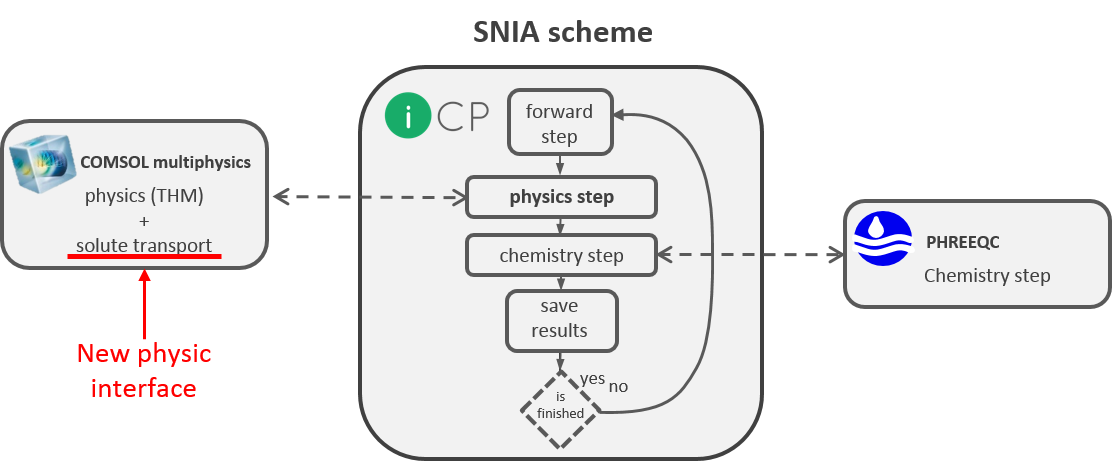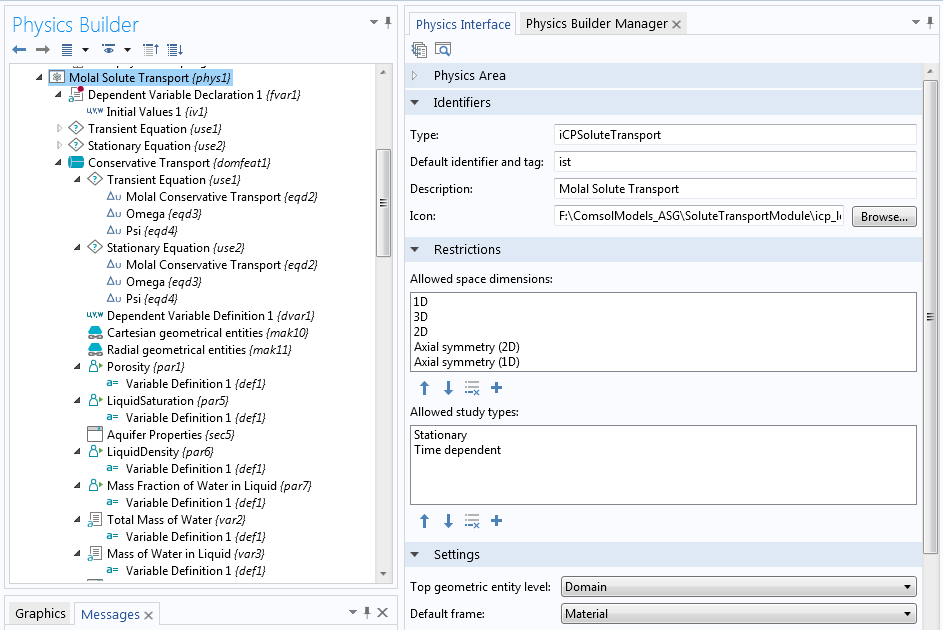- Published on
Molal solute transport: customized physics interface for iCP
- Authors
Author
- Name
- Álvaro Sáinzmail

Background
An interface coupling two standalone codes, the geochemical calculator PHREEQC (Parkhurst and Appelo, 2013) and the multiphysics software COMSOL (COMSOL, 2013), has been developed recently by Amphos 21. The interface, called iCP (Nardi et al., 2013), is able to simulate complex thermo-hydro-mechanical-chemical (THMC) models.
The reactive transport process is solved using the operator-splitting (OS) technique (Strang, 1968) with a sequential non-iterative approach (SNIA). In this method the conservative solute transport is computed in a first step with COMSOL (coupled with other physical processes if desired) while the geochemistry is solved in a second step with PHREEQC.

Despite COMSOL offers its own conservative solute transport interface, a new interface, “Molal solute transport”, have been developed for the specific needs of iCP. The interface is consistent with the units and the reactive transport formulation used in iCP.
Customizing COMSOL
The interface was implemented using the Physic Builder toolkit of COMSOL. Within the Physic Builder environment, users can design customized interfaces through an interactive desktop and without the need of coding. The tailored interfaces can be exported as a plugin that can be added into the plugins folder of COMSOL and loaded every time the program starts. The interface will be, then, available as any other COMSOL module.

In the finite element method the governing equations have to be defined in weak form. Three different ways are available to introduce the weak form in COMSOL. In this case the weak formulation was implemented to allow a variable number of unknowns.
The Molal solute transport interface is able to model transport by advection and diffusion-dispersion. The interface can be used for steady-state and time-dependent analysis and in all kind of geometries supported by COMSOL.
The interface
All features in the interface were tailored to meet the requirements of iCP. For instance, the term “Molal” comes from molality (mol/kg water), the default concentration units in PHREEQC; and the diffusion coefficient is constant for all the dependent variables, because in iCP formulation the transported elements are components and not “real” chemical species.

Three default nodes are added to the Model Builder when using the interface: Conservative Transport (the governing equation), No Flow (the default boundary condition), and Initial Values. Many other boundary conditions can be added: Fixed Concentration, Outflow, Open Boundary and Mass rate.
The interface has been tested in various models, both reactive and conservative transport, performing similarly to other solute transport codes.
Acknowledgements
This work was made possible by the funding from the European Union's through the CO2-ReactMarie Curie Initial Training Program and has been conducted at Amphos 21 in close collaboration with Albert Nardi
References:
[1] Parkhurst, D.L. & Appelo, C.A.J., 2013. Description of input and examples for PHREEQC version 3—A computer program for speciation, batch-reaction, one-dimensional transport, and inverse geochemical calculations. U.S. Geological Survey Techniques and Methods, book 6, chap. A43, p.497 p. Available at: http://wwwbrr.cr.usgs.gov/projects/GWC_coupled/phreeqc/
[2] COMSOL, 2013. Comsol Multiphysics. Version 4.3a, Available at: www.comsol.com.
[3] Nardi, A., Idiart, A., Trinchero, P., de Vries, L. M. and Molinero, J. (2013). ‘Interface Comsol-PHREEQC (iCP), an efficient numerical framework for the solution of coupled multiphysics and geochemistry’, Computers & Geosciences, submitted. Available at: http://image-modelling.net/icp.
[4] Strang, G., 1968. On the construction and comparison of difference schemes. SIAM J Numer Anal, 5, pp.506-17.